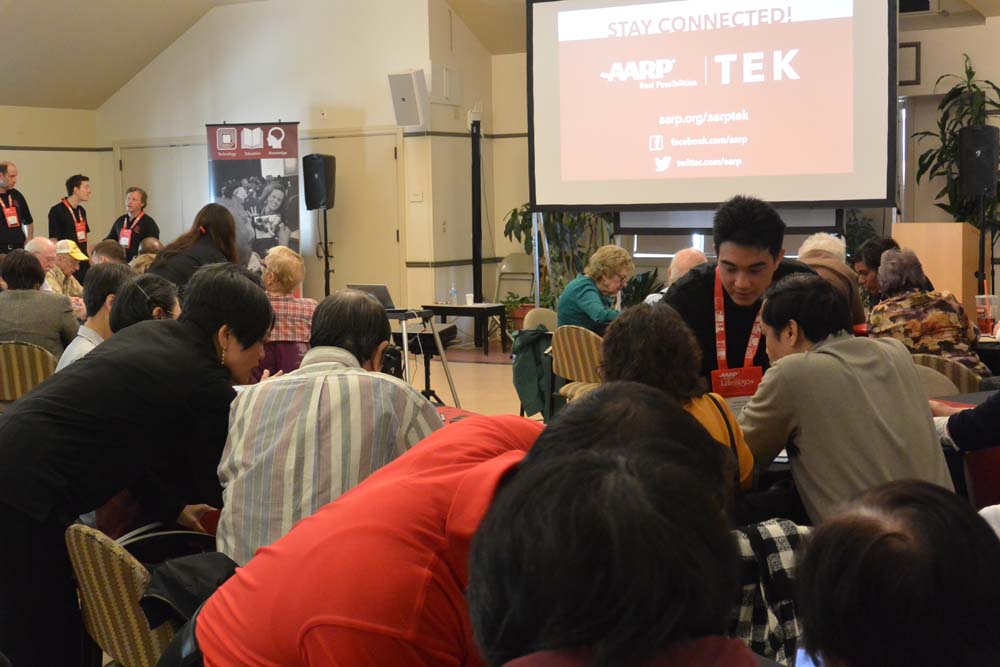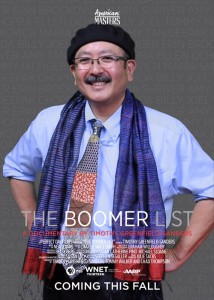30 May Asian America, social media and baby boomers

AARP’s TEK team helped elderly Chinese at a senior center in Boston learn to use smartphones, and they were sending texts ad shooting selfies at the end of the session.

This was a fun photo booth at the AARP Member Convention in Boston, which promoted an upcoming PBS series about baby boomers sponsored by AARP. Nope, I’m not actually in the series…
I started my career as a music critic and then a reporter, so I’ve always been able to write about pop culture – especially the pop culture of my generation, the baby boomers. Then when the Internet came along, I was able to move over to work almost exclusively in digital media, and these days I work in and speak about social media. And since I started writing my “Nikkei View” column and blog, I’ve been part of a growing chorus of Asian American voices (like the JACL’s Pacific Citizen, which is about to re-launch its website after a two-year hiatus!) covering issues and stories that mainstream media frankly tends to ignore.
So I couldn’t believe my great fortune last month when I was named the 2014 Asian American Journalists Association’s AARP Social Media Fellow.
AARP, if you aren’t familiar with the organization, is the American Association of Retired People, whose members are 50 years old and older. That means that this year, the youngest baby boomers are turning 50 and can join AARP (the baby boom went from 1946 to 1964).
This fellowship is perfect for me, because it combines the three passions that fuel my soul: My love for the era I grew up in, my embrace of online journalism and my involvement with and support for Asian Americans.
I’ll be posting messages on AARP’s AAPI Community Twitter and Facebook pages, and also write articles for AARP’s page specifically for Asian Americans and Pacific Islanders. Earlier this month I attended AARP’s Spring Member Event in Boston (there’s a Fall event coming up in September in San Diego) and posted social media updates and photo from the event. It was great to meet AARP staff, volunteers and members.
One of the coolest parts of the convention was a “Day of Service,” and one of the projects was a technology training session for seniors including 40 Chinese seniors, by AARP’s TEK group. For the first time, AARP had Mandarin and Cantonese speaking translators on hand to help the elderly Chinese learn how to use smartphones (see photo, above). It was a blast to watch the, learn how to send a text message, and shoot a “selfie!”
AARP is making serious efforts to reach out to Asian Americans. The organization describes itself as “a collection of diverse individuals and ideas working as one to influence positive change and improve the lives of those 50 and over. AARP members reflect a wide range of attitudes, cultures, lifestyles and beliefs.”
That range includes issues of healthcare, elder care, retirement planning, social security, legislative agendas, and lots more that affect Asian Americans. There are lots of ways they accomplish these goals, and one of them just won a prestigious award.
George Takei, the most famous Japanese American, thanks to his stint as “Hikaru Sulu” on the 1960s “Star Trek” TV series and ensuing hit movie franchise, speaks publicly about his childhood in an internment camp and his support for LGBT issues, is now a video star on YouTube and throughout various social media sites. Among his online avenues, he hosts “Takei’s Take,” a funny look at the Internet and technology through the eyes of a senior who embraces the cool new stuff, and inspires other seniors to do the same. “Takei’s Take,” which is produced by AARP, was named the “People’s Voice” winner in the Technology category for the Webby Awards. That’s proof that old dogs can learn new tricks.
Within our community, Asian American Pacific Islander Heritage Month is the perfect time to think about the issues that AARP highlights. Most older AAPIs were born outside the United States, and many don’t speak English at home, even if they’re naturalized citizens. So if you’re an “Issei” Asian American, you have different needs and challenges when it comes to services and information to live up to AARP’s motto, “Real Possibilities.”
If you’re a baby boomer Asian American, you share the cultural highlights of the generation (like growing up with rock and roll, and the pop culture of the ‘60s, ‘70s and ‘80s), and you should be thinking about your life after retirement, or how to stay healthy as you get older.
And, if you’re an Asian American from the younger generations, you may be thinking now about the responsibilities of caring for your parents and grandparents – because Asian culture emphasizes respect for elders, and lots of us have grandparents living with us at home.
This is an important time of generational transition for Asian Americans, so I’m thrilled to be working with AARP on these issues.
As part of my duties for the Fellowship, I’ll be moderating a panel at the June V3con Asian American Digital Media Conference in LA, and in July I’ll be moderating a plenary panel about social media at JACL’s National Convention in San Jose, which will be held July 9-12.
The good news is that more 50+ Asian Americans are online and on Facebook than older non-Asians. So I may not be telling you anything you don’t already know.
If any of you attend either (or both) events, and come say “hi” after the panel!
NOTE: An earlier version of this post was published in the Pacific Citizen newspaper of the JACL.
Here’s some interesting info about AAPIs from AARP:
Top 10 facts about AAPIs age 50 and older:
1) The majority (87%) of older AAPIs were born outside of the U.S., but most have become naturalized citizens (64%).
2) More than eight in ten (86%) older AAPIs speak a non-English language at home. Almost a quarter (24%) of older AAPIs are linguistically isolated and live in a household where no person over the age 14 speaks English very well.
3) Compared to other older Americans (60%), older AAPIs are more likely to be married (70%) and tend to live in three-generation households (17% of AAPIs age 50+ vs. 7% of total U.S. population age 50+ and 25% of AAPIs age 65+ vs 6% total U.S. population age 65+). The high marriage rate may be due to the fact that Filipinos, the second largest Asian group in the U.S., come from the only country in the world where divorce is illegal.
4) AAPIs age 65 and older are at more risk for economic insecurity in their later years compared to those in the total U.S. population of the same age:
• 14% are on food stamps vs. 9%
• 13% live in poverty vs. 9%
• 68% receive social security income vs. 86%
• 22% have retirement income from pensions and various retirement plans vs. 37%
5) AAPIs age 65 and older are more likely to be concerned about housing costs compared to the total U.S. population of the same age:
• 29% own their home free and clear vs. 48%
• 42% own their home with a mortgage vs. 31%
• 24% rent their home vs. 16%
6) Twenty percent of AAPIs age 50-64 have no health insurance, compared to 15% of the total U.S. population. Older AAPIs are almost twice as likely than older Americans to get their insurance from a health maintenance organization (27% vs. 15%).
7) Older AAPIs are more likely to access the Internet than other older Americans (75% in the past 30 days vs. 67%).
8) Older AAPIs visited Facebook at about the same rate as other older Americans in the past 30 days (39% vs. 38%), but are more likely to visit LinkedIn (13% vs. 8%) and three times more likely to visit Yelp (9 % vs. 3%).
9) Older AAPIs are more environmentally responsible compared to the other older Americans:
• 82% recycle glass, plastic, or paper vs. 69%
• 46% recycle electronics like batteries, cell phones, and computers vs. 37%
• 33% drive less or use alternative transportation vs. 28%
• 50% use cloth or other reusable shopping bags vs. 41%
• 52% use less water at home vs. 41%
• 24% buy organic food vs. 15%
10) Older AAPIs travel internationally frequently. More than half (53%) took a foreign trip in the past three years vs. 32% of other older Americans. AAPIs’ most likely travel destinations for the past three years were Asia and Europe (both 16%). Canada and Mexico are the third and fourth most likely destinations (13% and 10%).
The AARP Research Center analyzed data from the 2012 American Community Survey PUMS and a 2013 Scarborough USA English-language survey of more than 1,800 Asian Americans age 18 and older.




